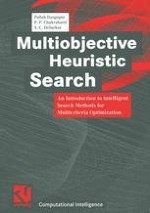A large number of problems require the optimization of multiple criteria. These crite ria are often non-commensurate and sometimes conflicting in nature making the task of optimization more difficult. In such problems, the task of creating a combined opti mization function is often not easy. Moreover, the decision procedure can be affected by the sensitivity of the solution space, and the trade-off is often non-linear. In real life we traditionally handle such problems by suggesting not one, but several non-dominated solutions. Finding a set of non-dominated solutions is also useful in multistaged opti mization problems, where the solution of one stage of optimization is passed on to the next stage. One classic example is that of circuit design, where high-level synthesis, logic synthesis and layout synthesis comprise important stages of optimization of the circuit. Passing a set of non-dominated partial solutions from one stage to the next typically ensures better global optimization. This book presents a new approach to multi-criteria optimization based on heuristic search techniques. Classical multicriteria optimization techniques rely on single criteria optimization algorithms, and hence we are either required to optimize one criterion at a time (under constraints on the others), or we are asked for a single scalar combined optimization function. On the other hand, the multiobjective search approach maps each optimization criterion onto a distinct dimension of a vector valued cost structure.
